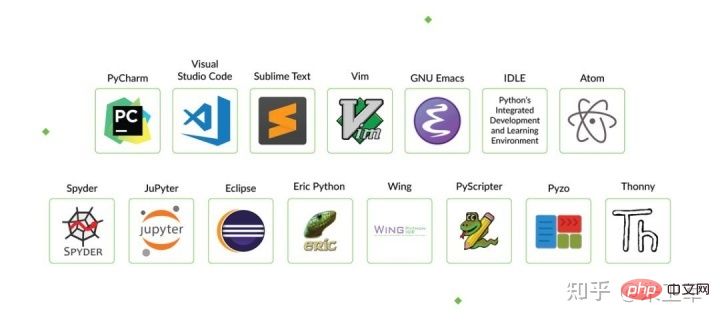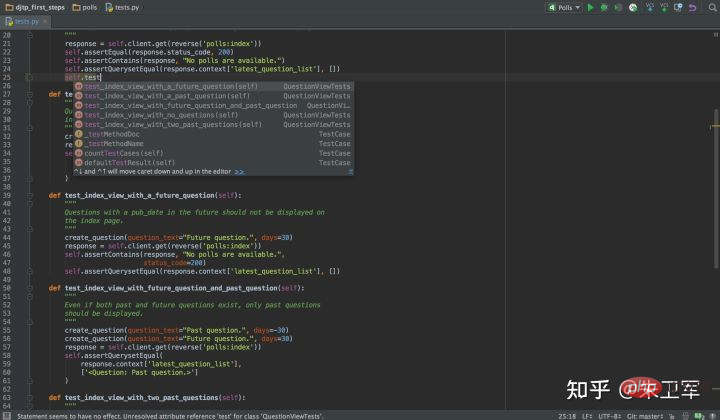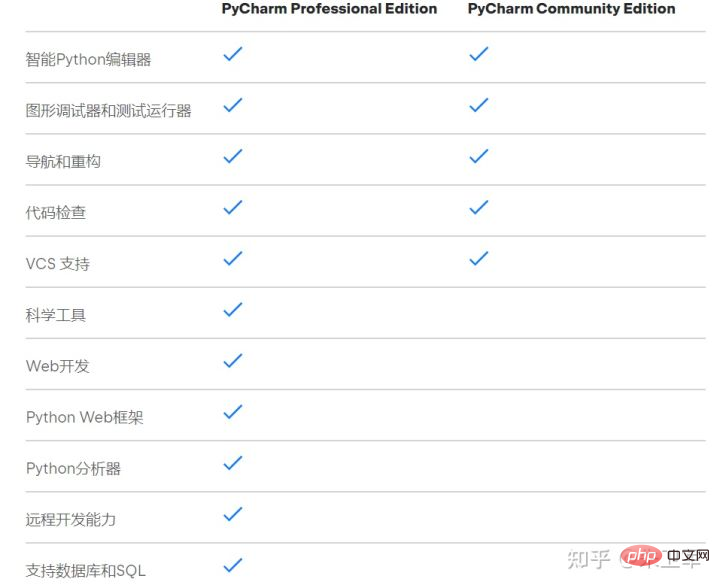Is PyCharm the best IDE for learning Python?
The most common question asked by Python beginners in the past two years is, what code editing tool should I use?
To be honest, I personally use Jupyter Notebook the most, mainly for frequent data visualization, which is convenient some.
But for beginners, PyCharm is still the best choice. I even recommend that you only use PyCharm.
From all current mainstream Python IDEs, PyCharm is the most suitable for Python. Developed, especially for novices, it can save a lot of unnecessary time and costs.

I also often use PyCharm to write scripts and occasionally develop some web applications. It can be said that no IDE can reach the level of perfection of PyCharm.
Compared with other IDEs, PyCharm has the following four main advantages, which will be introduced one by one later:
- Simple code editing environment
- Powerful intelligent code assistance Functions (intelligent code completion, code inspection, real-time error highlighting)
- Rich built-in developer tools (VCS, database, remote development, debugging, testing, performance analysis...)
- Complete web development and data science support (Django, Flask, JS, notebook, pandas...)

At the same time, PyCharm is a cross-platform application Program, compatible with Linux, macOS and Windows platforms.
PyCharm is a commercial tool from JetBrain, the Czech software company that developed IntelliJ IDEA and Kotlin.
Users can use 3 versions of PyCharm, namely Community Edition, Professional Edition, and Education Edition.
- The community version is free, but has many features removed;
- The professional version is paid and has complete functions, priced at US$199 for the first year, and discounts are available for renewal;
- The education version is free and is open to school students and educators. You need to have relevant qualifications to apply.

The features of PyCharm are detailed as follows (refer to the official website)
1. Smart code editor
PyCharm comes with smart code Editor that helps write high-quality Python code. It improves code understanding and readability by providing different color displays for keywords, classes and functions (i.e. syntax and error highlighting).
The code editor can also provide code completion, code inspection, real-time error highlighting and quick repair, and can realize automated code reconstruction and rich navigation functions.
2. Integrated Tools
PyCharm’s extensive out-of-the-box tools include integrated debugger and test runner; Python profiler; built-in terminal; integration with major VCS and built-in Database tools; remote development capabilities utilizing remote interpreters; integrated ssh terminal; and integration with Docker and Vagrant.
Some of the most basic integration tools provided by PyCharm include:
- Anaconda - A free, open source Python distribution for scientific computing that simplifies package management and deployment.
- IPython - A powerful command shell for interactive computing.
- Kite - an artificial intelligence powered autocomplete plugin.
- Pylint - Source code, bug and quality checker.
- pytest - A framework for writing small tests for Python code.
- WakaTime - A developer dashboard with productivity metrics and automatic time tracking
3. Data Science and Machine Learning [Pro only]
PyCharm supports scientific libraries such as Matplotlib and SciPy to help Python developers complete data science and machine learning projects.
4. Google App Engine [Pro version only]
Google App Engine, or simply App Engine, is a PaaS and cloud computing platform designed to develop and host web applications .
It provides automatic scaling functionality for web applications. The professional version of PyCharm provides support for Google App Engine.
5. Comprehensive debugging and testing
General IDEs support debugging and testing programs, and PyCharm is no exception. It provides an integrated Python debugger and line-by-line code coverage. Integrated unit testing.
6. Multi-technology development [Professional version only]
Python developers can use PyCharm to create web applications. As a result, Python IDE supports popular web technologies, including CoffeeScript, CSS, HTML, JavaScript, and TypeScript.
In addition, it also includes support for Cython and SQL.
PyCharm also provides a real-time editing function, that is, developers can create/modify web pages while pushing web pages in real time. Therefore, changes can be tracked directly on the web browser. Web applications can also be built using AngularJS or NodeJS.
7. Project and Code Navigation
The code navigation feature makes it easier for developers to navigate to classes, functions, or files. It also helps significantly reduce the effort and time required to edit and enhance Python code. File structure view and dedicated project view are always available.
lens mode allows developers to thoroughly inspect and debug the entire Python source code. With code navigation, you can locate elements, variables, etc. in virtually no time. Developers can quickly switch between classes, files, and methods.
8. Refactoring
The refactoring function in PyCharm helps improve the internal structure of the Python program without affecting the external performance of the Python program. Making changes to local and global variables is efficient and fast.
9. Remote development
PyCharm allows running, debugging, testing and deploying applications on remote hosts or virtual machines.
For this purpose, Python IDE provides:
- Integrated SSH terminal
- Docker and Vagrant
- Remote interpreters
10. Support for popular Python web frameworks [Pro version only]
PyCharm allows developers to leverage Django in Python development projects. The Python IDE provides auto-completion functionality, and you can also use Django to write debugging code.
PyCharm also supports other popular Python frameworks such as Flask, Pyramid and web2py.
11. Version Control System (VCS) Integration
Version Control System (VCS) simply tracks changes made to files, applications, and other information sources.
PyCharm provides a unified user interface for CVS, Git, Mercurial, Perforce and Subversion.
The above is the detailed content of Is PyCharm the best IDE for learning Python?. For more information, please follow other related articles on the PHP Chinese website!

Hot AI Tools

Undresser.AI Undress
AI-powered app for creating realistic nude photos

AI Clothes Remover
Online AI tool for removing clothes from photos.

Undress AI Tool
Undress images for free

Clothoff.io
AI clothes remover

Video Face Swap
Swap faces in any video effortlessly with our completely free AI face swap tool!

Hot Article

Hot Tools

Notepad++7.3.1
Easy-to-use and free code editor

SublimeText3 Chinese version
Chinese version, very easy to use

Zend Studio 13.0.1
Powerful PHP integrated development environment

Dreamweaver CS6
Visual web development tools

SublimeText3 Mac version
God-level code editing software (SublimeText3)

Hot Topics
 1653
1653
 14
14
 1413
1413
 52
52
 1306
1306
 25
25
 1251
1251
 29
29
 1224
1224
 24
24
 How to use the chrono library in C?
Apr 28, 2025 pm 10:18 PM
How to use the chrono library in C?
Apr 28, 2025 pm 10:18 PM
Using the chrono library in C can allow you to control time and time intervals more accurately. Let's explore the charm of this library. C's chrono library is part of the standard library, which provides a modern way to deal with time and time intervals. For programmers who have suffered from time.h and ctime, chrono is undoubtedly a boon. It not only improves the readability and maintainability of the code, but also provides higher accuracy and flexibility. Let's start with the basics. The chrono library mainly includes the following key components: std::chrono::system_clock: represents the system clock, used to obtain the current time. std::chron
 How to measure thread performance in C?
Apr 28, 2025 pm 10:21 PM
How to measure thread performance in C?
Apr 28, 2025 pm 10:21 PM
Measuring thread performance in C can use the timing tools, performance analysis tools, and custom timers in the standard library. 1. Use the library to measure execution time. 2. Use gprof for performance analysis. The steps include adding the -pg option during compilation, running the program to generate a gmon.out file, and generating a performance report. 3. Use Valgrind's Callgrind module to perform more detailed analysis. The steps include running the program to generate the callgrind.out file and viewing the results using kcachegrind. 4. Custom timers can flexibly measure the execution time of a specific code segment. These methods help to fully understand thread performance and optimize code.
 How to use string streams in C?
Apr 28, 2025 pm 09:12 PM
How to use string streams in C?
Apr 28, 2025 pm 09:12 PM
The main steps and precautions for using string streams in C are as follows: 1. Create an output string stream and convert data, such as converting integers into strings. 2. Apply to serialization of complex data structures, such as converting vector into strings. 3. Pay attention to performance issues and avoid frequent use of string streams when processing large amounts of data. You can consider using the append method of std::string. 4. Pay attention to memory management and avoid frequent creation and destruction of string stream objects. You can reuse or use std::stringstream.
 How to understand DMA operations in C?
Apr 28, 2025 pm 10:09 PM
How to understand DMA operations in C?
Apr 28, 2025 pm 10:09 PM
DMA in C refers to DirectMemoryAccess, a direct memory access technology, allowing hardware devices to directly transmit data to memory without CPU intervention. 1) DMA operation is highly dependent on hardware devices and drivers, and the implementation method varies from system to system. 2) Direct access to memory may bring security risks, and the correctness and security of the code must be ensured. 3) DMA can improve performance, but improper use may lead to degradation of system performance. Through practice and learning, we can master the skills of using DMA and maximize its effectiveness in scenarios such as high-speed data transmission and real-time signal processing.
 How to optimize code
Apr 28, 2025 pm 10:27 PM
How to optimize code
Apr 28, 2025 pm 10:27 PM
C code optimization can be achieved through the following strategies: 1. Manually manage memory for optimization use; 2. Write code that complies with compiler optimization rules; 3. Select appropriate algorithms and data structures; 4. Use inline functions to reduce call overhead; 5. Apply template metaprogramming to optimize at compile time; 6. Avoid unnecessary copying, use moving semantics and reference parameters; 7. Use const correctly to help compiler optimization; 8. Select appropriate data structures, such as std::vector.
 How to uninstall MySQL and clean residual files
Apr 29, 2025 pm 04:03 PM
How to uninstall MySQL and clean residual files
Apr 29, 2025 pm 04:03 PM
To safely and thoroughly uninstall MySQL and clean all residual files, follow the following steps: 1. Stop MySQL service; 2. Uninstall MySQL packages; 3. Clean configuration files and data directories; 4. Verify that the uninstallation is thorough.
 How to use MySQL functions for data processing and calculation
Apr 29, 2025 pm 04:21 PM
How to use MySQL functions for data processing and calculation
Apr 29, 2025 pm 04:21 PM
MySQL functions can be used for data processing and calculation. 1. Basic usage includes string processing, date calculation and mathematical operations. 2. Advanced usage involves combining multiple functions to implement complex operations. 3. Performance optimization requires avoiding the use of functions in the WHERE clause and using GROUPBY and temporary tables.
 What is static analysis in C?
Apr 28, 2025 pm 09:09 PM
What is static analysis in C?
Apr 28, 2025 pm 09:09 PM
The application of static analysis in C mainly includes discovering memory management problems, checking code logic errors, and improving code security. 1) Static analysis can identify problems such as memory leaks, double releases, and uninitialized pointers. 2) It can detect unused variables, dead code and logical contradictions. 3) Static analysis tools such as Coverity can detect buffer overflow, integer overflow and unsafe API calls to improve code security.




